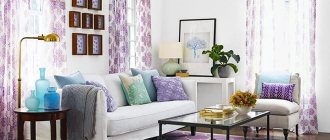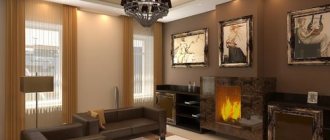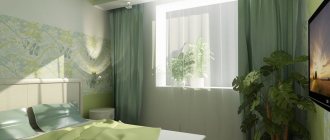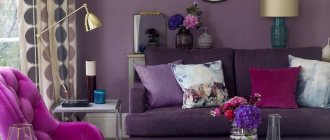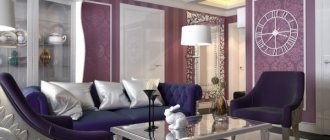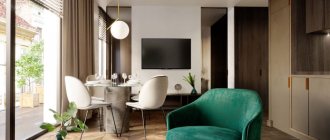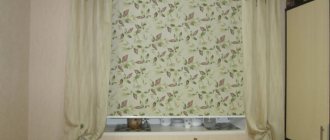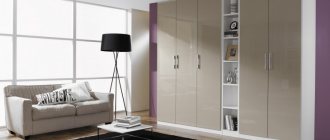Purple color in the interior is popular today. It is original, unusual, but it must be used wisely so that the room looks pleasant, and not tacky and depressing.
Purple color is obtained by mixing two colors - blue and red. It has many shades from refined and delicate to rich, intense. There are subtleties of combining purple color with other colors. The right combination makes it possible to create a variety of images in the interior.
What color goes with lilac in the interior?
The variety of cold and warm shades allows you to combine it with a wide variety of colors. The most successful and popular is combination with:
- white;
- gray;
- green;
- yellow;
- beige;
- black;
- blue
Each of these colors (even white) has a rich range of shades, so there are endless combination options. You can choose pale green, soft violet, and then the interior will turn out airy and relaxing. Or you can take a bright light green or rich purple, and the same room will have a completely different mood.
Lilac with white
The interior in lilac and white looks elegant and restrained. This combination is suitable for both the living room and the bedroom. So, in a classic living room you can put white laminate or marble tiles on the floor. For walls, choose white wallpaper, plain or with a soft pattern. Furniture should also be in gray and white tones.
And the accents in such an interior will be placed using purple and lavender flowers. The carpet on the floor, sofa cushions, curtains, decorative items - all this will be in shades of lilac. You can decorate the bedroom in a similar way: walls, ceiling, floor, furniture in shades of white, and textiles and accessories in lavender color. The “arrangement” of priorities can be changed, and paint one or two walls lilac, put a sofa and armchairs with purple upholstery.
The kitchen also looks unusual in this color scheme. The set can have white and lavender facades. But so that your eyes don’t get tired, there should be more white here, so it’s better to make the work surface look like natural marble and order a pearl-colored dining set.
Lilac with gray
This combination of two calm, discreet shades is more suitable for the bedroom and living room. To make the room as relaxing as possible, make the walls light gray. They are not distracting and will be a good background. The sofa, carpet or laminate can be darker shades of grey. And the coffee table, textiles, photo frames, floor lamps - everything should be in purple and lilac tones.
For classic interiors, wallpaper with vertical gray-violet stripes is suitable. Against their background, white furniture, ivory-colored accessories and a crystal chandelier in the center of the ceiling will look good. Such wallpaper is also suitable for the corridor - with them it will seem more spacious and taller.
Combining gray and purple is a popular design technique that is used to create interiors of different styles. For example, the bay window of a kitchen in a private house can be decorated in this color scheme. Place a brown board of a noble shade on the floor, apply light gray textured plaster on the walls, the furniture can also be light brown. The highlight of this interior will be the purple curtains on the windows. You can place vases with bouquets of lavender and put a linen violet runner on the table.
Lilac with green
The atmosphere in this room depends on the saturation of the selected shades. The combination of bright lilac and green is suitable for the kitchen. You can install a set with glossy facades in a rich light green color, and paint the wall above the work surface a rich lilac color. Apply a floral design to such a wall using light green paint. To balance the interior, you can put brown laminate on the floor.
The nursery can also be made in this color scheme, but choose calmer tones. Glue wallpaper with green and white vertical stripes on the walls, choose a lilac-white set. Textiles and various little things can be green in such a room. For the bedroom, this color combination is also often chosen, but in pastel shades. Olive-colored furniture against powdery lavender walls always looks beautiful.
Lilac with yellow
This combination is typical for oriental interiors. For example, you can choose mustard wallpaper with a large lilac pattern and dark brown laminate. Cabinets and shelving can be made of wood, painted brown or gold. In the center of such a living room there should be a purple sofa, on which there will be gold, orange and red pillows.
This color scheme is also suitable for a Baroque-style bedroom, but the shades should be “powdered.” Walls, textiles, and carpet are made in light purple tones, and furniture can be in noble yellow-golden shades. Yellow, purple and lavender can be used to decorate a rustic kitchen.
Lilac with beige
This combination is universal and is used in the decor of hallways, bedrooms, children's rooms, and living rooms. Each of these colors can act as a background color or they can be present in the interior in equal proportions. These colors are ideal for decorating rooms in typical apartments. A room with a lot of beige color seems more spacious.
In the living room or bedroom, you can choose creamy beige wallpaper with a simple pattern for the walls, and put light brown laminate on the floor. Upholstered furniture, curtains, sconces can be lilac and violet. An interior in brown tones, in which there are only two or three purple shades, looks very stylish. Such beauty can be created without the help of a designer - there are hundreds of photos of successful interiors in these colors on the Internet.
Lilac with black
Not everyone will decide on this bold color combination. Black seems gloomy to many, so they try to minimize its presence. Those who decide to experiment with color will receive a stylish interior.
Make a hallway, bedroom or living room in this color scheme. You can put white laminate or carpet on the floor. It is also advisable to make the doors and ceiling white. Paint the walls black and stick lilac wallpaper with an abstract pattern on only one. A designer black chandelier will take place in the center of the ceiling, and charcoal-colored furniture will be located along the walls.
A modern living room can be decorated in this color scheme. For example, choose a black-brown shelving unit and graphite-colored wallpaper. You need to put in a white high-pile carpet, purple sofas and floor lamps with black lampshades. If you are not ready for global changes, start small - make an office, library or relaxation area on the balcony in black and purple colors.
Let's sum it up
Brown in the interior is one of the most interesting choices. It is not as obtrusive as red, blue, or yellow, and at the same time not as simple as chromatic tones. It is devoid of mysticism, but at the same time mysterious, because when entering a room in brown tones, you can never say with certainty who the owner is: a sober and boring pragmatist or a person with excellent taste. On the other hand, playing with shades and combinations, you can emphasize your individuality. Working in an office decorated with expensive stained oak, welcoming guests in an elegant vintage living room, falling asleep with cherry and coffee in the bedroom, you will everywhere feel the special comfort that only brown colors can give.
Features of color and influence on the psyche
Lilac means a bleached purple color, it belongs to the cool spectrum of tones and is well suited for rooms with windows facing east and south. Adding more red paint warms up the hue, so it can be used even in northern rooms.
The soft lilac color fits harmoniously into many interior styles: it is relevant in both classic, modern, and vintage styles. The shade brings its charm to any room, giving a person a powerful energy boost. In psychology, lilac has an important meaning: it symbolizes sensuality, mystery, creativity and romanticism.
Shades of lilac
In nature, shades of lilac in pure form are rarely found - mainly in the flower petals of lilac and some other plants. But even there are more than forty varieties of lilac, and there are many more artificially created lilac tones. Using shade tables, designers determine the tone that is suitable for a particular situation, and then select companion colors to match it.
The most popular colors in interior design are:
- classic lilac;
- gray-lilac;
- soft lilac;
- soft violet;
- bluish-lilac;
- pale lilac;
- lavender;
- blue-lilac;
- blurry purple;
- beige-lilac;
- lilac pearlescent;
- cyclamen;
- silver-lilac;
- amethyst, etc.
All differences in tones are due to the proportion of blue and red, as well as the amount of white and the presence of additives of other colors. For example, a pastel white-lilac color contains a lot of white, while blue-lilac is easier to call blue with a lilac tint: it is so dark. There is a lot of pink in the violet color; dusty lilac has a muted, blurry tone, which is why it is very popular in design.
The combination of lilac in different rooms
You need to plan your design depending on the purpose of the room, as well as the level of illumination. When the room is located on the sunny side, the shades should be darker. On the contrary, a cool room whose windows face north and do not receive natural light should be decorated with soft, warm shades.
Living room
When using this shade, it is important to maintain an overall balance. If the wallpaper is light, with a barely noticeable lilac tint, you can make the furniture, curtains, and accessories darker. White leather furniture or a blue velor set with armchairs will look good against a lavender background.
Warm lilac tones in the living room go well with different wood shades. For the south side of the house, where there is a lot of light, a duet of lilacs with a blue tone is a good choice, which will give a feeling of cleanliness and coolness. To create an aristocratic atmosphere, you can combine a pale shade of lilac with purple, burgundy, and dark brown. Gray colors have a special charm; they can and should be combined with lilac to decorate the room.
Bedroom
By adding different floral shades, the bedroom takes on a special charm and an atmosphere of romance. Pastel colors of lilac will make the space calm and very cozy. Dark curtains, bed linen, and prints on tulle should become brighter spots. Lilac accents in combination with emerald on a light background will look good.
Kitchen
Lilac will also come in handy for the kitchen, because this color is not banal, absolutely not boring. Combining it with contrasting shades, you can get a very interesting design. You should not oversaturate the kitchen space with color: it is believed that it reduces appetite, although for those on a diet this will be an additional advantage.
To avoid visually reducing the size of the room, you should not use plum and other dark colors in a small kitchen. It is better to add pastel shades of lilac here, combining them with white, gray, and green tones. Black details and accessories will add a luxurious touch, although the lighting will need to be improved to eliminate the gloom.
Other tips for decorating your kitchen:
- small patterns on the wallpaper are suitable only for an interior made in a rustic style;
- Light curtains go well with lilac - too heavy, massive materials should be abandoned;
- a lilac set can quickly become boring, so it is better not to introduce shades of lilac in furniture;
- Light purple dishes, furniture, watches, picture frames look original.
Children's room
Lavender, violet, lilac are quite suitable tones for creating an interior in a girl’s room. They evoke thoughts of fairy-tale dreams, calm you down, and give you a great mood. The palette allows you to embody the most interesting ideas. You can introduce floral tones in furniture, posters, stickers, pictures.
In a nursery, lilacs should be combined with blue, yellow, green, pink, and pistachio. You can decorate the room in more modest colors, and decorate only the playing area with lilac - this option is also used by designers.
Hallway
In this case, it is appropriate to use both the lilac color of the walls and accents in the form of separate accessories. If there is little light in the hallway, you should give preference to light shades of walls and floors - this will visually expand the room. In a small hallway you should use no more than 3-4 colors. You can shade lilac with pastel colors, gold or contrasting combinations (brown, yellow, turquoise).
Bathroom
The standard bathroom is small in size. Soft, delicate tones of lilac will help to visually expand the space of the room, but for this, one more condition must be met - the presence of sufficient, but soft lighting. The light should not be bright, but darkened corners are excluded.
In the bathroom, it is best to combine lilac with olive, gray and white, while using more than three tones is not recommended. You can decorate the floor and ceiling in the same color, and make the walls light. Bathroom accessories can be lilac, but in darker tones, although you don't need too much of them.
Combination with pink
The combination of brown and pink adds elegance to the room, makes it warm, even cheerful. That is why the use of this combination in children's rooms is very acceptable. Pink is the color of happiness, tenderness, and dreaminess, which harmonizes perfectly in combination with calm and peaceful brown. The use of this palette to decorate a nursery is fundamental and very harmonious.
However, it is used with pink not only in children's rooms. Decorating your bedroom with these flowers will add romance to its inhabitants. The use of various shades of these colors, as well as various decorative elements that emphasize certain objects, has always been widely used in interior design.
Experiments with pink and brown are always exciting for designers and true connoisseurs of interior beauty: their results are impossible to predict, but they always turn out worthy. Therefore, this combination can also be used when arranging a living room or kitchen.
Using lilac in the interior
This color is very rare in nature, so it is unusual for the human eye and it is easy to overdo it in clothing, interior or design. It gives the room freshness, visually expands the space, creates a feeling of comfort, lightness, and airiness.
There is an opinion that it cannot be used in large rooms, but that preference should be given to smaller ones, as it greatly affects human perception. But the owner’s wishes are much more important. So, if you want to decorate your entire bedroom, living room, or even apartment in this color, don’t be afraid. Unless you live with someone who would be uncomfortable with it.
Pastel shades
Pastel color is warm, so using it with brown in the design of a room will give it a soft, calming character. Brown and pastel belong to the same color scheme, differing only in the presence of light tones. Therefore, these two colors combine perfectly with each other, complementing each other in a balanced manner. The brown-pastel interior personifies harmony, inner peace, while creating an aura of security and peace of mind, which has a beneficial effect on the internal state of those in the room.
That is why the most common combination of these color palettes is found in bedrooms and living rooms. These rooms, which are zones of relaxation and restoration of human vitality, express calmness and protection from external stimuli. Ideally, the use of brown and pastel colors in the interior of any room pleases the eye if you add some accents and zest to them. An experienced designer will always be able to find the optimal solution to this issue: he will highlight the key elements of the room in pastel brown tones using decorative items, proper lighting or textile materials. But this should not be abused!
The use of bright elements should not create a feeling of pompousness and cloyingness in the room.
How to use lilac color
To decorate a bedroom in lilac tones, you should plan the design based on the level of illumination in the room. If the room is very bright and located on the sunny side, then you should use darker shades. They will set the right mood of lightness and coolness, while creating contrast and not whitening the room too much.
Lilac in the living room can be used both as an accent color, highlighting an important space in the interior, and as a filler color. For example, a good solution would be to make a wall in this color, using it as a panel for photographs and paintings. In this case, you can and even need to use darker shades of lilac.
Another option is to paint the walls a light lilac color. It will not distract attention from other interior items and will maintain the lightness and light of the room. Designers also prefer to use cream and milky shades together with lilac, because they add a cozy atmosphere.
Photo of purple bedroom design
Note! Upholstered bedroom - 100 photos of the best ideas for upholstered furniture for the bedroom
Let's discuss this article together:
Click to cancel reply.
What to consider
Yes, not everyone has good taste or at least a basic understanding of color, so there are some rules, following which it is much easier to avoid making gross mistakes.
Color has several parameters, due to which a combination with different shades of another color can look either great or absolutely terrible.
Lilac, unlike purple, does not need to be diluted with other colors - it is self-sufficient in itself. Although, you shouldn’t get carried away and make the entire room in this color, it can play a cruel joke on you. Also, unlike purple, lilac does not compress space.
You should not use more than four shades of the same color. Since lilac is a shade balanced with both cold and warm undertones, its gradient is very wide. Its variations are scattered across the widest spectrum, from the coldest to the warmest shade.
Bathroom and corridor
A bathroom with such coloring will be filled with bliss, romance and cleanliness, allowing you to enjoy peace and quiet. Any tones in combination with white and beige are applicable here. The decor will be:
- Colored towels.
- Wicker baskets.
- Mirrors.
- Vases.
- Rugs.
- Living vegetation.
The hallway area, open to positive energy from the outside, should not be overloaded with colors and furniture. The most successful solution is a lilac-white tandem, which guarantees elegance and pleasant impressions for household members and guests.
Adding sun
The combination of lilac color in the interior with pale yellow shades makes the interior more refined and noble. In this case, lilac can be darker, with a grayish undertone.
Lilac tones go well with yellow, creating contrast. Such a duet is rare in nature and therefore unusual for the human eye. A good example is pansies.
The combination of lilac and yellow in the kitchen interior is very bright. Objects of this coloring are good for demarcating space. The interior in this case turns out to be light, sunny and quite catchy.
In the case of children's bedrooms, it is recommended to dilute the coldness and detachment of a lilac shade with colorful and energetic yellow, creating a mood of spontaneity and energy.
Deciding on shades
By itself, the lilac shade in the interior can look boring and dull, so most often wallpaper of this type is combined with coatings and decorative elements of a different color scheme .
The best option, regardless of which room you decide to decorate in purple tones, will be shades of white or beige. Firstly, such a palette will serve as an additional source of light in your interior . Secondly, delicate pastel shades will highlight the relaxing atmosphere created by purple wall materials. White, cream, light gray and other calm tones can be used not only on the walls, but also in furniture, textiles, and small accessories placed around the room.
Since lilac shades are considered natural and reflect a floral theme , the option of using similar tones that convey spring freshness and beauty is considered successful. These are pink, soft green, bluish, pistachio, peach and other tones.
Tip: to ensure harmonious transitions between bright shades, as well as visually “dilute” the oppressive environment, use another shade. These can be light inserts on wallpaper, glossy snow-white pieces of furniture, as well as textiles with spring patterns on a light background.
The lilac palette can be combined with colors such as red, brown, chocolate, black, blue and many others. But such combinations can only be implemented if your room is sufficiently lit and large in size. Otherwise, your room will feel cramped and uncomfortable.
Combinations of purple and black are recommended to be diluted with opposite shades, for example, white or light pink.
Among the shades that are not suitable for purple interiors are orange, yellow, pale green, light green and many others, which, in tandem with a gentle and romantic background, will create a boring or overly bright environment.
Floor and ceiling decoration
If the housewife decided to decorate the floor in a purple shade, then the walls and ceiling can be of any color, but at least 1 tone lighter than the floor. You can paint the surface in almost any room. If there is good lighting, bright accents stand out beautifully against its background.
When choosing a purple ceiling, you should familiarize yourself with some details:
- a rich ceiling can only be created in large areas with high ceilings;
- a bright ceiling is suitable for a room decorated in a minimalist style;
- This ceiling looks harmonious with white, beige furniture, caramel, milky walls.
When decorating a floor or ceiling in a purple shade, the room will create the effect of high cost, aristocracy and a sense of style.
Combination with blue and orange
Blue and orange interior elements look very harmonious against the background of light brown walls. Interestingly, harmony in the use of these colors is achieved through the influence of their absolutely opposite properties. Blue is the color of coolness, suppression of emotions. Orange is, on the contrary, a source of warmth, sunshine and good holiday mood. The whole secret of a successful combination of this trio of colors lies in the predominance of positive qualities when they influence a person. Blue gives austerity, orange fills the room with a depth of light, and brown replenishes the feeling of peace with calm.
These colors look good separately on a brown background, but still, it is believed that their best combination occurs in pairs.
Wall decoration
You can paint the walls in a purple hue, but you should remember the nuance. If the owner has chosen a rich, deep color, then it will absorb the free space. If there is an empty wall in the room, then it is recommended to paint it. It will help hide unevenness, defects and roughness.
Lavender shade is used to decorate the ceiling and walls in an apartment or house. But if the room is small, then you need to choose cold tones. They should be barely noticeable. This will help achieve lightness and airiness in the interior.
Purple walls in the interior do not need to be completely painted. You can use accents. The shade is also used when dividing a room into zones. For example, all walls are painted beige, and one wall is painted rich purple.
Lilac textiles: texture matters
The purple tint in textiles is an excellent solution for creating coziness and comfort in the home. Sofas, armchairs or chairs decorated in lavender tones are pleasing to the eye. They relax and make you want to sit down or lie down.
You can experiment with chairs, completely wrap them in lilac upholstery or partially paint them. If the interior of the room is restrained and monochrome, then eggplant or lavender chairs will add zest and complement the composition. If you introduce a dark and rich color, it will not violate the seriousness of the design and rigor.
Purple shades in the interior will not be annoying if you purchase bedspreads, rugs, high-pile rugs, bed linen and curtains in this color.
Don't be intimidated by this color when creating a design indoors. There are many shades; with the right combination with other tones and choosing a specific area or objects that can be decorated in purple colors, the room will have a solemn, festive, cozy atmosphere.
Combination with purple
Quite a popular color combination for the interior of houses in recent years. This is a combination of luxury on the one hand, and comfort on the other. However, one should not neglect the advice of psychologists who say that when paired with brown and purple, it has a suppressive effect on the people’s psyche. This composition sterilizes emotions, suppresses will, induces melancholy and sad moods.
Therefore, the interior of brown-violet tones is categorically contraindicated for creative people, strong, strong-willed individuals, since here they will have nowhere to draw energy. A purple-brown room is more likely to become a place of filling some sensual pleasures than a zone of comfort and relaxation.
Kitchen-living room interior with lilac walls and furniture
In this room, the designer managed to perfectly combine royal purple with soft chocolate color. Chocolate shades are more present in the kitchen and living room areas. For the facades of the upper cabinets, we chose the color of coffee with milk, which helps create harmony and comfort. A playful mosaic on a kitchen apron will be a great way to wake you up in the morning.
Two opposite walls in the sleeping area were covered with purple textured wallpaper. Since this area is located in a corner, good lighting was required. A huge chandelier in the form of a suspended round lampshade and LED strips along the contour of the suspended ceiling allow you to create different lighting variations.
The rest of the living space ceiling has rows of spotlights. A modular sofa with chocolate upholstery is a modern solution to the problem of sleeping space. A couple of meters away there is a living room, a table and 6 chairs.
